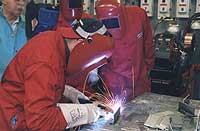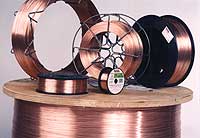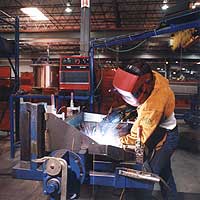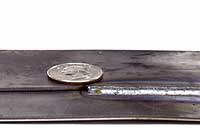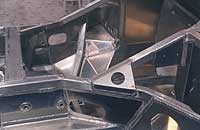Reducing Your Welding Costs
Many companies strive to get the best possible price on welding equipment and consumables. Although this is an admirable goal, these companies may be overlooking the big picture which says that rather than aim for a savings based on a one-time purchase price, look for ways to get productivity savings. By reducing overall welding costs, the productivity savings that are realized multiply year after year. Productivity savings will allow a company to keep saving even when the price of equipment, consumables or welding accessories goes up.
Looking at the typical work cell model, you will notice that only 20 percent of the cost of welding is related to materials, while the bulk of the costs - more than 80 percent - are attributed to labor and overhead. Hence, if a company saves 10 percent on the material costs of welding, the company is only saving two percent of the total welding costs. But, if a company can save 10 percent on the costs associated with labor and overhead, the company will achieve an eight percent savings on the total welding costs in the work cell model. The work cell information is valid for manual or semi-automatic welding process mild steel application.
Outlined below are 10 steps that companies can take to reduce welding costs and realize productivity savings in the cost of doing business. These are some of the most common items that Lincoln Electric examines when auditing a company.
1. Analyze the delivery of consumables and accessories to the welding points
In many shops, the operator has to go to a tool room or supply area for a new contact tip, coil of wire or other welding accessory. This takes valuable time away from the welding cell and slows down overall productivity. To improve the operating efficiency and minimize wasted time, companies should stock at least a limited supply of all necessary items near the welding station - this includes shielding gas, flux and wire. Another helpful productivity enhancing tip is to switch to larger spools of wire such as from 25 lb. spools to 44 or 60 lb. spools to even larger packages of 1,000 lb. reels or 1,000 lb. drums. A simple switch like this means less changeover time, which adds up over the weeks, months and years.
Shops should also be on the lookout for shielding gas waste. A simple device called a surge turbine can be placed at the end of the gun to provide a digital readout of the gas surge and flow rate. If the surge rate is high, investing in a surge guard can reduce the pressure, eliminating gas surges and waste.
Leaks in the gas delivery system can also create a potential loss of money. By looking at the amount of consumables purchased each year and then examining the total gas purchased, a company can determine if there is a significant loss. Welding manufacturers and distributors should be able to provide average utilization figures so that loss can be detected. If there is a loss suspected, one of the easiest ways to check for leaks is to shut off the gas delivery system over the weekend. Check the level on Friday evening and then again on Monday morning to determine if gas was used while the system was in shut down mode.
2. Analyze whether material handling is effective
Delivery of parts to the welding station in an organized and logical fashion is also a way to reduce welding costs. For example, one company was manufacturing concrete mixing drums. In the fabrication process, the company produced 10 parts for one section, then went on to make 10 parts of another drum section, etc. As pieces came off the line, they were put onto the floor of the shop. When it was time to weld, the operator had to hunt for the pieces needed and sort through them. When the outside welding expert pointed out the amount of time being wasted in this process, the company started to batch each one on a cart. In this way, the pieces needed to weld one drum were stored together and could easily be moved to the welding area.
This type of scenario is also true for companies that may outsource parts to a vendor. Though it may cost more to have parts delivered in batches, it may save more in time than having to organize and search through parts to be able to get to the welding stage.
How many times each piece is handled in the shop may be an eye-opener to reducing wasted time. To measure such an intangible as this, operators are asked to put a soapstone mark on the piece each time it is touched - some companies are surprised to find out how many times a part is picked up, transported and laid down in the manufacturing process. In the case of one company, moving the welding shop closer to the heat treatment station eliminated four extra times that the part was handled. Basically, handling a part as few times as possible and creating a more efficient production line or work cell will reduce overall costs.
3. Look for ways to correct overwelding
One of the "cardinal sins" that almost every shop does is overweld. This means that if the drawing calls for a 1/4" fillet weld, most shops will put down a 5/16" weld. The reasons? Either they don't have a fillet gauge and are not exactly sure of the size of the weld they are producing or they put in some extra to "cover" themselves and make sure there is enough weld metal in place.
But, overwelding leads to tremendous consumable waste. Let's look again at our example. For a 1/4" fillet weld, the typical operator will use .129 lbs. per foot of weld metal. The 5/16" weld requires .201 lbs. per foot of weld metal - a 56 percent increase in weld volume compared to what is really needed. Plus, you must take into account the additional labor necessary to put down a larger weld. Not only is the company paying for extra, wasted consumable material, a weld with more weld metal is more likely to have warpage and distortion because of the added heat input. It is recommended that every operator be given a fillet gauge to accurately produce the weld specified - and nothing more. In addition, changes in wire diameter may be used to eliminate overwelding.
4. Enhance current welding processes and procedures
Look for ways to create more efficiencies in the welding process. This includes examining such things as wire diameter, wire feed speed, voltage, travel speed, gas type, transfer mode, etc. For instance, if the shop is currently welding with a short arc process and a 75/25 blend of shielding gas, it may be more effective to switch to a different gas and a spray mode of transfer. Or, a change in process may be warranted based on the condition of the part. If there is oxide on the part, it may be easier to change to a process that will overcome contamination problems rather than try to clean each part before welding. Your welding supplier should be up to date on the latest technology and be able to advise you on new processes, machinery and consumables that can optimize welding at the shop.
5. Optimize joint preparation
In some cases, it may be better to double bevel a joint to prepare it for welding rather than single bevel it. It is recommended to double bevel any material that is more than 3/4" in thickness. Just this simple change in procedure can save quite a bit in weld metal. On a 3/4" thick piece, a double bevel will use 1.45 lbs. per foot of weld metal while a single bevel will use 1.95 lbs. per foot.
6. Eliminate any extra welds from the design
Look for ways to modify product designs to eliminate unnecessary welds. For example, one company that manufactured boxes originally had a design that called for welded lift handles on each side of the box. By simply changing the design of the box to cut out lifting slots, it eliminated the need for welding the handles - saving time and money. In another instance, rather than making a part with an open corner, the design was changed to accommodate a closed corner, which meant 1/3 less metal required to fill the corner.
7. Look for items that can be welded rather than cast
We've already discussed ways to eliminate welds to create efficiencies, but what about adding welds? In some cases, it may be more cost effective to weld metal pieces to a part rather than cast the entire component in a costly alloy or exotic metal. For example, a company that originally used a part cast in a high-nickel alloy found that 50 percent of the part could be composed of standard, structural steel which allowed a savings in material and thus a savings in total cost. Also, the company was further able to redesign the part so that it was more efficient.
8. Look for ways to eliminate costly record keeping
Many companies get completely "bogged down" in the paperwork required to run a business. But with today's latest technological advances, there are items that can be a great help. For instance, Lincoln Electric offers something called ArcWorks software which can document procedures, create drawings everyone in the shop can access, keep track of welding operator's qualifications, and many other things. Software such as this can be tailored to the individual company's needs and provide great efficiencies and also eliminate mistakes.
9. Adding robotics or hard automation to the operation
Today's technological advances offer many options. Robotics can be justified when the volume of parts a company produces is so great that it can offset the monies spent on a robot. Robotics can also be considered if there are a number of different parts that are similar enough in nature to be able to be handled by the same robot.
If robots are not justified, a company might determine that fixturing or hard automation could be used to increase efficiency or quality. One company incorporated fixturing and clamps to hold down a tank while the seam was being welded. In another case, an automotive manufacturer decided that automation was necessary because of the amount of parts and intricate angles and welding positions.
10. Examine safety concerns
Although it may not lead to immediate welding cost reductions, operating under proper safety techniques will save money in the long run by reducing employee accidents. Safety items to consider may include chaining gas cylinders so they can't fall, installing flash arrestors to eliminate blow back when oxyfuel cutting or labeling piping to avoid mishaps.
Conclusion
These are just some of the items that are considered when The Lincoln Electric Company performs its Guaranteed Cost Reduction program. Under this program, a team of Lincoln welding experts visits a facility and performs an audit. A menu of cost reduction ideas is then presented to the company from which they choose and prioritize. Lincoln will calculate the savings and actually guarantee a certain amount of savings if the ideas presented are implemented. If those savings are not realized, Lincoln will write a check for the difference.
As the old saying goes, "don't be penny wise and pound foolish" - look for ways to decrease welding costs, increase efficiencies and improve productivity, these are the savings items that will reap benefits time and time again.

